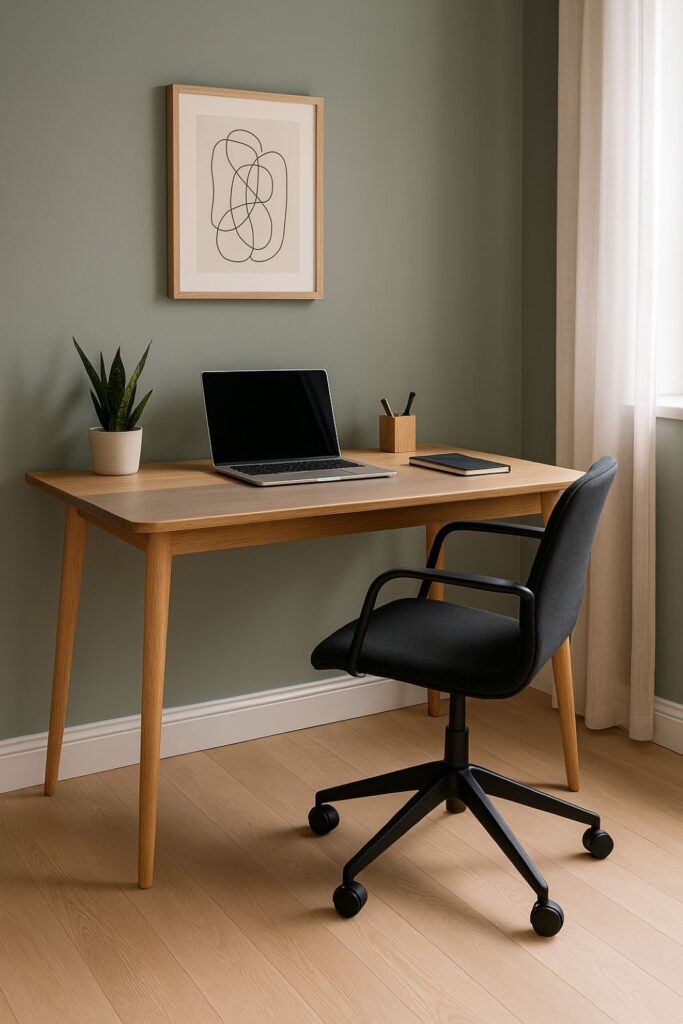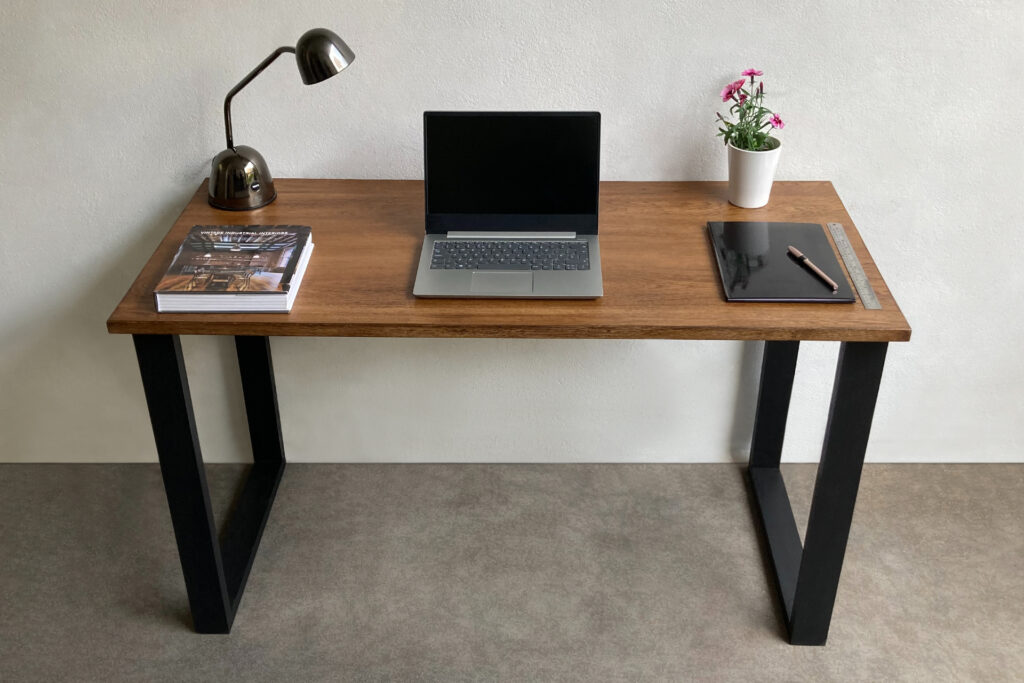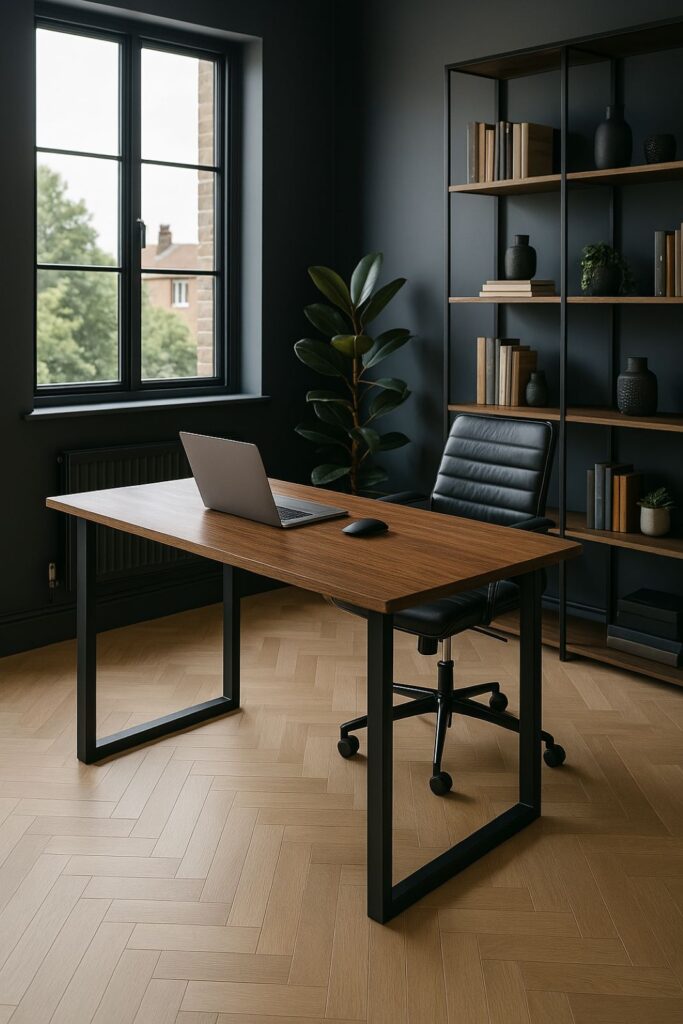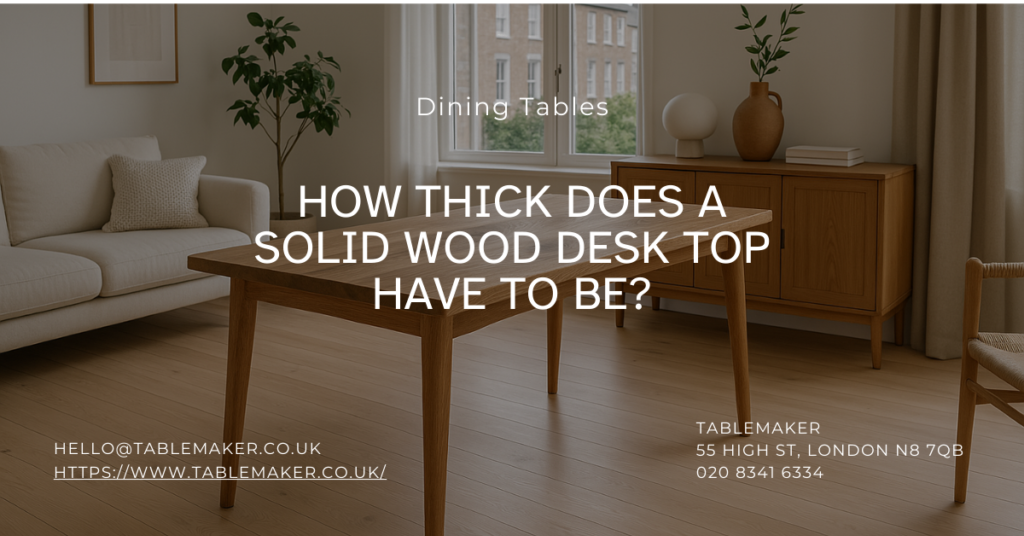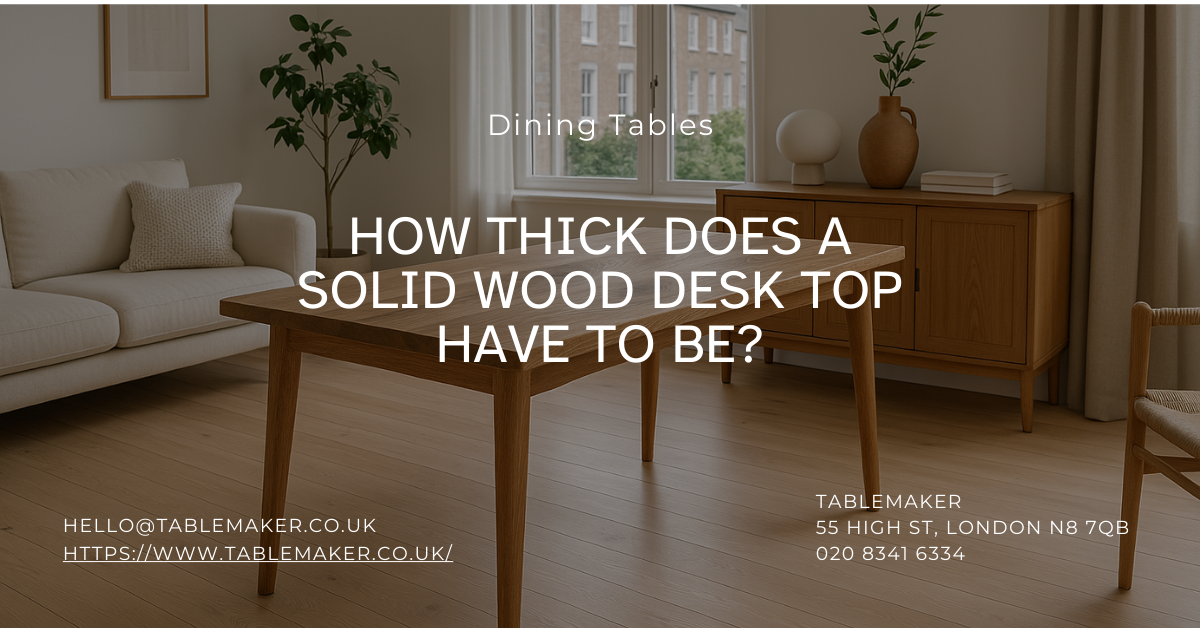
How thick does a solid wood desk top need to be?
What is the best thickness for a solid wood desk top?
The best thickness for a solid wood desk top depends on the size, usage and style of the desk. In general, solid wood tops range from 18 millimetres to over 40 millimetres thick. For most desk setups, a thickness between 22 and 32 millimetres offers the ideal balance between strength, aesthetics and cost. Thicker tops over 40 millimetres tend to be used more for visual impact rather than structural necessity.
In this article about solid wood desk tops we have covered
- What is the best thickness for a solid wood desk top?
- Standard thickness options for solid wood desk tops
- 18 millimetres
- 22 to 24 millimetres
- Around 32 millimetres
- What about solid wood tops over 40 millimetres?
- Does wood type affect thickness choice?
- How do I know if my desk top will bow?
- Are veneered tops different?
- Can I use a desk frame with a solid wood top?
- Can I customise the appearance of my desk top?
- Summary: Which thickness is best for your desk?
- Did you know?
- Need help choosing your desk thickness?
- FAQs
Standard thickness options for solid wood desk tops
Solid wood desk tops are available in a few standard thicknesses. The most common are 18 millimetres, 22 to 24 millimetres and around 32 millimetres. These thicknesses are used across a wide range of furniture, including desks, dining tables and kitchen islands.
18 millimetres
A solid wood top with 18 millimetres of thickness is perfect for smaller desks where a minimalist look or tighter budget is a priority. This lighter option still has plenty of strength when well supported and is often used for compact workstations or wall-mounted setups. If the desk is more than 1100 by 700 millimetres, or lacks edge to edge frame support, then a thicker top or additional bracing may be needed to prevent bowing over time.
22 to 24 millimetres
This is the most popular range for home office and commercial desks. It offers a more substantial look and feel without adding too much weight. This thickness provides excellent stability and strength, supporting up to 1.8 metres of unsupported span in oak or walnut. Many height adjustable frames also support this weight comfortably, especially if replacing an MDF top.
Around 32 millimetres
Tops in this range are noticeably thicker and often used to create a chunky, high quality appearance. In terms of performance, a 32 millimetre oak or pine top can span up to 2.8 metres without needing additional support. This thickness is ideal for larger setups such as dual monitor desks or extended workstations. The added depth also allows for more decorative edge profiles like bullnose, chamfer or custom finishes.
What about solid wood tops over 40 millimetres?
While solid wood tops over 40 millimetres thick are available, they are less common due to cost and sourcing challenges. These thicker boards are generally chosen for aesthetic impact rather than structural need. They are most useful for statement pieces or installations where the desk top is the centrepiece.
If you want the appearance of a thick top without the full cost or weight, drop down or built up edges can be used. This technique involves attaching a strip of the same wood under the edge of the top to create a thicker look without increasing the entire board’s thickness. It works well for wall-mounted desks or where visual weight matters more than actual strength.
Does wood type affect thickness choice?
Yes, the species of wood can affect how thick the top needs to be. Hardwoods like oak and walnut are denser and more durable, allowing them to provide better support even at lower thicknesses. Softwoods like pine may require more thickness or additional bracing to avoid indentation or warping over time, especially under heavy loads like monitor arms.
Pro Tip: Choose oak or walnut if you plan to use monitor arms — these hardwoods handle clamp pressure far better than pine.
How do I know if my desk top will bow?
Whether a solid wood desk top will bow depends on its length, thickness and support. A general guideline based on oak is:
18 millimetres: no bowing up to around 1 metre of unsupported span
22 to 24 millimetres: no bowing up to 1.8 metres
32 millimetres: stable up to 2.8 metres
This is based on oak’s strength, so for pine or other softer woods, slightly shorter spans are recommended. Ensuring your frame supports the entire underside of the desk helps prevent deflection or long-term sagging.
Are veneered tops different?
Yes. Veneered desk tops are built from a core of MDF, plywood or chipboard, with a thin layer of real wood on top. These are commonly produced in thicknesses like 18, 25, 30 or 38 millimetres. While they look similar to solid wood, they do not have the same structural strength. This means they may require more support, especially for longer desks or if used with accessories like monitor arms.
Can I use a desk frame with a solid wood top?
Absolutely. Most solid wood tops are compatible with standard desk frames. It is important to double check the frame’s weight capacity. For example, a 22 millimetre oak top is significantly heavier than the MDF top many standing desks come with. Make sure to account for the wood weight, especially for electric adjustable frames. Most manufacturers provide load capacities, and if you’re replacing a lighter top, you can often use that difference to your advantage.
For reference, The Guardian published a feature on how hybrid working is shaping the future of home office setups, with increased interest in higher quality materials.
Additionally, a study by the highlighted how ergonomics and desk choice impact productivity and wellbeing:
Can I customise the appearance of my desk top?
Yes, thicker solid wood tops allow for more flexibility in terms of edge profiles and finishes. Common options include rounded corners, chamfered edges or bullnose styles. Finishes such as oil, stain or whitewash can also be applied to suit your space.
If you want a thicker appearance without the full weight, adding a front lip or using a supporting skirt with the desk legs can enhance the look affordably. These options are popular with wall-mounted tops or desks where visual presence is important.
Pro Tip: For tops thinner than 22mm, make sure your desk frame has edge-to-edge support to prevent bowing over time.
Talk to our London Table Expert
Ask us about custom thickness desk tops for your workspace
Summary: Which thickness is best for your desk?
For most setups:
Choose 18 millimetres for a budget-friendly, sleek look for small desks
Opt for 22 to 24 millimetres for a balanced, versatile option with wide compatibility
Go with 32 millimetres for a premium feel and support for long spans
Consider 40 millimetres or more if design and aesthetics are the main focus
Choose a thickness that matches your desk size, frame type and visual preference. If you’re unsure, speak to a supplier or visit a showroom where solid wood tops can be seen and tested.
Did you know?
Design experts often recommend allowing at least 50–60cm of width per person when placing desks or tables in shared spaces, to ensure proper comfort and use.
Source: The GuardianUK office furniture standards often account for workspace ergonomics, recommending desk depths of around 60–80cm — which influences the ideal thickness and stability of solid wood tops.
Source: The Independent
Need help choosing your desk top thickness?
Not sure which size or thickness suits your setup? Get in touch with Tablemaker – your trusted furniture maker in London with five-star reviews. We make solid wood desk tops to order – no MDF, no veneers, just proper wood built to last.
Address: 55 High St, London N8 7QB
Phone: 020 8341 6334
Email: hello@tablemaker.co.uk
Google rating: 5.0 ★
Frequently Asked Questions About Solid Wood Desk Top Thickness
How thick should a solid wood table top be?
For most solid wood tables, a thickness of 22mm to 32mm is ideal. It provides a balance of strength and visual weight. Thinner tops, like 18mm, work well for smaller desks or where a lighter look is preferred. Thicker options like 32mm or more offer a more substantial feel and are often chosen for larger setups or for aesthetic reasons.
Is 19mm thick enough for a desk?
Yes, 19mm can be strong enough, especially if the desk isn’t very wide and has a supportive frame underneath. Using a hardwood like oak or walnut helps improve strength and prevent bowing. For wider desks or those using monitor arms or heavy equipment, stepping up to 22mm or adding extra support is usually a good idea.
Is 1 inch thick enough for a desk top?
1 inch (25.4mm) is a very common and practical thickness for a solid wood desk top. It provides a good level of durability and strength, especially with hardwoods like oak. It’s also thick enough to allow for cable notches or rounded edge profiles without compromising the structure.
Is a solid wood desk worth it?
A solid wood desk is absolutely worth it if you value durability, natural appearance, and long-term use. Unlike MDF or veneer, solid wood can be sanded and refinished, so it lasts for years — even decades. It also handles daily wear better and brings a real warmth and character to any workspace.
Tablemaker
55 High St, London N8 7QB
02083416334
HVQM+58 London

